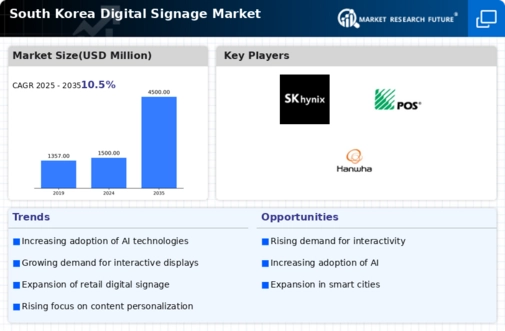Expansion of Smart Cities
The development of smart cities in South Korea is significantly influencing the digital signage market. As urban areas evolve, there is a growing need for efficient communication systems that can disseminate information to the public. Digital signage plays a crucial role in this context, providing real-time updates on transportation, weather, and local events. The South Korean government has invested heavily in smart city initiatives, with an estimated budget of over $1 billion allocated for infrastructure improvements. This investment is expected to drive the adoption of digital signage solutions, as municipalities seek to enhance public engagement and improve the overall quality of urban life. Consequently, the digital signage market is poised for growth as cities integrate advanced technologies into their communication frameworks.
Increased Focus on Data Analytics
The digital signage market in South Korea is witnessing a growing emphasis on data analytics to enhance advertising effectiveness. Businesses are increasingly leveraging data-driven insights to optimize their digital signage content and placement. By analyzing consumer behavior and preferences, companies can tailor their messaging to resonate with target audiences. This trend is supported by advancements in analytics technologies, which allow for real-time monitoring and adjustments to digital signage campaigns. As a result, the digital signage market is likely to see a shift towards more strategic and data-informed approaches, enabling businesses to maximize their return on investment. The integration of analytics into digital signage strategies may lead to improved customer engagement and higher conversion rates.
Growing Demand for Interactive Displays
The digital signage market in South Korea is seeing a significant increase in demand for interactive displays.. This trend is driven by the increasing consumer preference for engaging and immersive experiences. Retailers and businesses are increasingly adopting touch-screen technology and interactive kiosks to enhance customer interaction. According to recent data, the market for interactive displays is projected to grow at a CAGR of approximately 15% over the next five years. This growth is indicative of a broader shift towards personalized marketing strategies, where businesses leverage digital signage to create tailored experiences for their customers. As a result, the digital signage market is likely to see a significant transformation, with interactive displays becoming a central component of marketing strategies across various sectors.
Rise of E-commerce and Omnichannel Strategies
The digital signage market is being propelled by the rise of e-commerce and the adoption of omnichannel strategies by retailers in South Korea. As online shopping continues to gain traction, brick-and-mortar stores are increasingly utilizing digital signage to create a seamless shopping experience that bridges the gap between physical and digital platforms. Retailers are investing in digital displays to showcase promotions, product information, and personalized content that resonates with consumers. Recent statistics indicate that the e-commerce sector in South Korea is expected to reach approximately $100 billion by 2026, further emphasizing the need for effective in-store digital signage solutions. This trend suggests that the digital signage market will continue to expand as retailers seek innovative ways to attract and retain customers.
Government Initiatives Supporting Digital Transformation
The South Korean government is actively promoting digital transformation across various sectors, which is positively impacting the digital signage market. Initiatives aimed at enhancing digital infrastructure and encouraging technological innovation are creating a conducive environment for the adoption of digital signage solutions. Government programs that support small and medium-sized enterprises (SMEs) in implementing digital technologies are particularly noteworthy. With funding and resources allocated to facilitate this transition, SMEs are increasingly adopting digital signage to improve their marketing efforts and operational efficiency. This governmental support is likely to drive growth in the digital signage market, as more businesses recognize the value of digital solutions in enhancing their competitive edge.













Leave a Comment